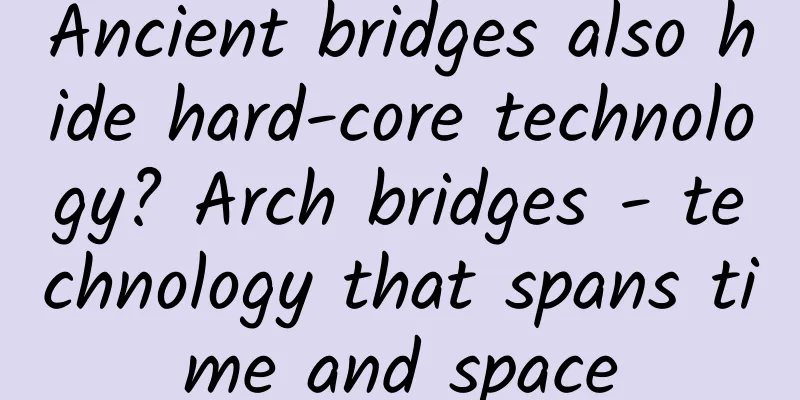Ancient bridges also hide hard-core technology? Arch bridges - technology that spans time and space

|
When we talk about the technology in ancient buildings, we tend to think of towers and palaces, but we often overlook a low-key existence - bridges. They are not so magnificent, but they hide exquisite mechanical structures and engineering designs. Today, we will take a look at three of the "outstanding" ones. 1. Zhaozhou Bridge It is the oldest existing stone arch bridge. Over the past 1,400 years, it has experienced ten floods, eight wars, and countless earthquakes, but it still connects the two banks. Why is it so stable? The "arch" structure can decompose part of the downward gravity and pressure into thrusts on both sides, which is very suitable for bridge construction. Most of the previous bridges were semicircular arches, but if the span was large, the bridge deck would be very high. Not only would it be tiring for people to walk, but the construction was also very dangerous. The Zhaozhou Bridge uses a circular arch design, with the arch height and span being 1:5, allowing people and cars to pass easily. On the other hand, it also changed the solid shoulder arch to an open shoulder arch, that is, two small arches at each end of the large arch, which is the first in the history of bridges in the world. This not only looks good, saves materials, but also reduces the weight of the bridge itself by hundreds of tons! With less gravity, it is naturally more stable. The two pairs of small arches can also bear the force, making the large arch more relaxed. It has to be said that "the arches give way to each other" (——homonymous pun, deduct money!) When the rainy season comes, the small arches on the shoulders can also increase the flood discharge and reduce the impact on the bridge body. Inside, which you cannot see, all the stones are laid along the direction of the bridge, and can be neatly cut into 28 "pieces" of independent arches. If any arch is broken, it can be replaced separately, which is very convenient for maintenance. Will it fall apart? Don't worry, the ancients took creative scientific measures and used metal materials to make up for the shortcomings of stone: 5 iron tie rods passed through the arches, fastening them, just like fastening a seat belt (the exposed round iron ball is the head of the seat belt); there are also "waist irons" behind the adjacent stones to lock the stones together, which can enhance stability like modern steel bars, allowing the stones to be connected hand in hand into a stable whole. 2. Marco Polo Bridge When you mention this bridge, your first reaction may be the "Stone Lions of Lugou Bridge" in the elementary school textbook. More than 500 stone lions of all sizes guard this bridge. Unlike the Zhaozhou Bridge, it is a multi-hole arch bridge with 11 small arches that share the pressure and increase the flood discharge area. They bear the weight of vehicles and pedestrians together; when floods come, they discharge the flood together; when earthquakes come, they bear the pressure together. The small arches "work together" to keep this more than 200-meter-long bridge standing safely for more than 800 years. The water-facing side of each pier is made into the shape of a bow. If it is made into a square shape, the river water will hit it and it will be easy to break after a long time. The boat-shaped pier allows the river water to flow smoothly and reduce the impact. Each pier also has its own weapon, commonly known as the "Dragon Slaying Sword", which is intended to scare away the evil dragon and prevent it from causing trouble. However, it is actually a triangular iron column installed to divert floods and fight against ice. The metal not only supports the stone on the surface, but is also hidden deep inside the stone bridge. The foundation of Lugou Bridge is so stable because there are thick iron rods that string the stones together like skewers and firmly planted on the riverbed. 3. Guangji Bridge It is a combination of stone and wood, an arch bridge and a floating bridge. This mixed ancient bridge is located in Chaozhou, Guangdong, where there is abundant rainfall, frequent typhoons and frequent floods. Therefore, the flood control of Guangji Bridge incorporates unique technology. For example, its overall structure is flexible like a Transformer. The two sides are solid stone bridges, while the middle part is a floating bridge that can be opened and closed. It is made up of 18 wooden boats connected side by side and covered with wooden boards as the bridge deck. If there is a flood, it can be dismantled to discharge the flood. When encountering problems that are difficult to solve with human power, smart brains come up with innovative solutions, and gradually technology is developed. These ancient bridges seem to connect history and the future, allowing us to discover the ancients' understanding of mechanics and their clever use of different materials. Therefore, even ancient buildings with a long history are full of technological elements. Author: Hikka Slate Restoration Group Reviewer: Liu Jie, Associate Professor, School of Architecture and Art, Beijing Jiaotong University Produced by: China Association for Science and Technology Department of Science Popularization Producer: China Science and Technology Press Co., Ltd., Beijing Zhongke Xinghe Culture Media Co., Ltd. |
<<: Flu, parasites, cancer...you heard it right, dinosaurs can get sick too!
Recommend
The largest merger in the automotive industry has been completed! The world's fourth largest automaker with annual revenue exceeding one trillion is born
Although the epidemic is still raging, it has not...
Android 6.0 will be pushed next week, with a lot of new features
Google confirmed at last night's new product ...
Android App design architecture MVC MVP MVVM and architecture experience
Like the MVC framework mode, the Model model hand...
Samsung's self-driving technology may have surpassed Apple and is targeting Google
Since 2012, the most fascinating and heart-wrench...
Android market cannot wait for a hot small-screen phone
This new iPhone SE may become Apple's best-se...
91 Ten Articles - New Energy Vehicle Industry Briefing: Sony Concept Electric Vehicle to be Open to the Public at the End of the Month
1. Benefiting from the clear-cut electric vehicle...
Insect antennae are so weird
Source: www.countytimes.co.uk Huer Insects are ve...
Money-Making Calendar 2021, why is the Money-Making Calendar 2021 so popular?
What is the art of making money? There are three ...
The flatter the face, the cuter it is? Garfield cats and Pekingese dogs are more likely to get these diseases
Flat nose, big forehead, round and flat face as i...
Does the click-through rate of Baidu's bidding account have any impact on the promotion plan?
(1). The keywords of plan 1 are affected by the c...
Ocean Love Story Series丨Anglerfish——This Sticky Love
Author: Scientific Scraps Reviewer: Zhang Wei, As...
NIO receives investment from Tesla's largest external shareholder, with its share price rising 22%
On October 9, Scottish asset management company B...
Why is the Milky Way shaped like ripples in a pond? Scientists may have found the reason
Image: The Milky Way's long, wavy arms Imagin...
Electric Technology Car News: Can the younger and more alternative Dongfeng Fengshen, inspired by cats, lead the trend in the hardcore SUV trend?
In today's automobile trend, the appearance o...
Detailed explanation of the core of Pinduoduo’s gamification operations!
The street stall economy suddenly became popular ...









